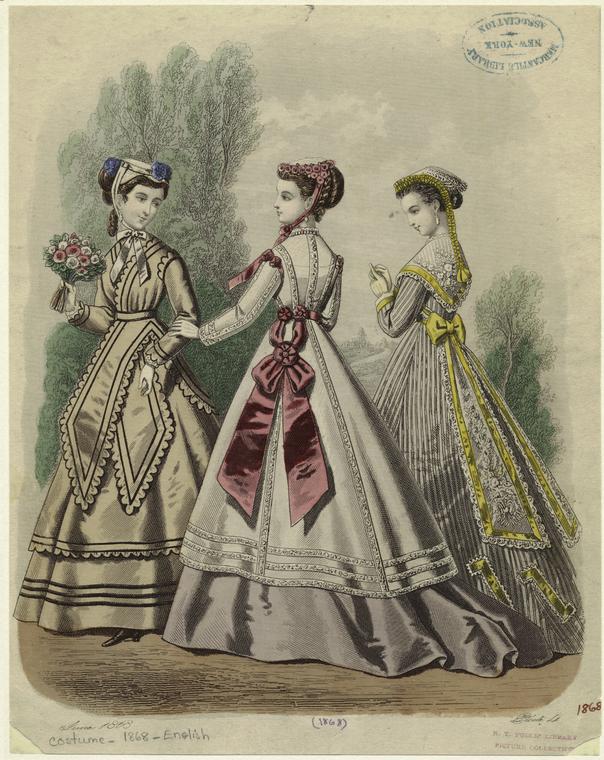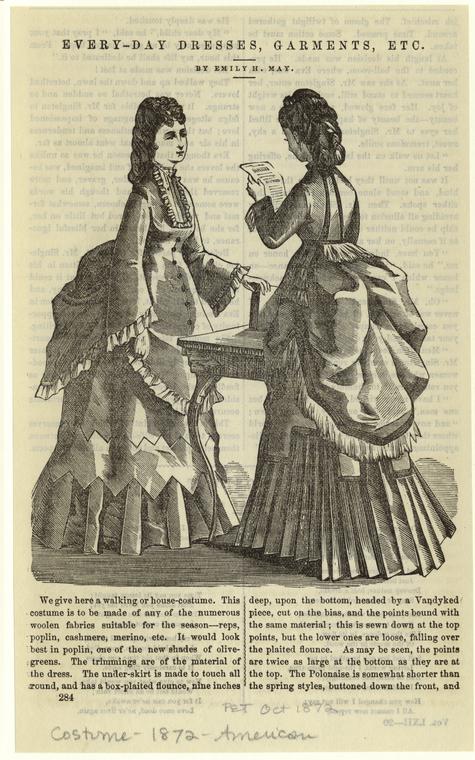(For a while I intended to join in on the Historical Sew Monthly 2015, using it to put together an outfit for a Halloween wedding, but I realized that the themes were not lining up exactly with what I needed to sew. Before I thought I might participate properly in '15, I came up with the idea of participating by writing an in-depth post on the subject for each period, and I decided to go back to that idea.
For January - Foundations - I'm looking at the development and evolution of the mid-nineteenth century hoop skirt to the bustle.)
Something I find very interesting about the history of clothing is the contrast between the fluidity and briefness of periods of various fashions, and the way we solidify them by naming them and choosing to concentrate on specific periods. That's a
very jargony way of putting it, sorry; an example would be that the trend of a bell-shaped hoop lasted for only about five years, but somebody who chooses to recreate that period is, in a way, making it last for decades.
When I started writing this essay, I was originally thinking that the focus on specific eras makes the transitions between them take a back seat, described off-handedly as skirts gradually getting fuller or waists gradually getting lower or sleeves gradually getting wider until the next era starts - but after thinking about it more, what's really going on is that the history of fashion is the history of transitions. Eras named for political periods are especially subject to this, but periods named for one aspect of dress (such as "the hoop era", or if you were to call 1827-1835 "the big sleeve era") contain a lot of changes in other aspects.
And when it comes to these changes, there are generally 1) a series of discrete steps that appear to be a gradual slide from a more distant perspective and/or 2) outliers appearing sporadically and then becoming fashionable. For example, waistlines dropped at the end of the 1810s to the middle of the ribcage, then to the natural waist around 1824, with occasional examples of natural waistlines between 1820 and 1824. This is an elaboration on the usual statement that waistlines began to drop or gradually deepened during this period, which gives the impression that every year or season they slowly went lower and lower. (I'm definitely guilty of doing this myself all the time; I'm trying to get better at specificity.)
One transition that gets the unelaborated treatment frequently is, as you may have guessed from the title, the one from the hoop to
the bustle. To get a proper look at it, we have to start in the 1850s, with the advent of the hoop itself. The "skeleton skirt" was patented in 1856, with various inventors coming up with variations and improvements in order to get in on the profitable new fashion. The fashionable skirt had had a bell shape for several decades: during the early 1840s it was comparatively narrow, but it widened in 1848, and then again in 1854 (with possibly a slight narrowing in 1851). By the end of 1856, with the addition of the hoop, it had widened again. The hoop didn't cause the trend - it only supported a slight expansion of it.
More importantly, the hoop skirt allowed for different shapes. Without a support, layers of petticoats will create a belled shape, fullness bursting out from the waistline. (Petticoats that are made from rectangular panels gathered or pleated to a waistband, that is.) While the cage crinoline just exaggerated this shape at first, in 1860 the implications of a wired petticoat seem to have hit: the fullness over the hips stopped being the fashionable shape. Instead, the skirt descended in a smooth curve down from the waist, bowing out into a graceful curve around thigh or knee level.
 |
| Fashions for September 1861, Godey's Lady's Book; NYPL 803346 |
Like the petticoats mentioned above, skirts in the 1840s and 1850s had always been cut from broad panels and pleated or gathered at the top. Cutting the skirt panels in gores, as began to happen in the early 1860s, got rid of the need for heavy pleating at the top, emphasizing the smooth line over the hips and the fact that a woman was not achieving her silhouette with layered petticoats.
 |
| June 1868, unknown periodical (Peterson's?); NYPL 803508 |
The smooth line was extended down to the ankle by the end of 1865, with what's now called the elliptical hoop. Extra fullness in the back had been important to fashionable silhouettes from the beginning of the century, even with the first hoop skirt, but this version of it projected out into a kind of train. Because of the conical shape, it was especially suited to the gored skirt. A higher waistline started to became fashionable at the same time, possibly in part to emphasize the steep slope. After this, however, the changes picked up speed: by 1868, raised waistlines were firmly a part of fashion, and the elliptical hoop changed again: finally shrinking in the hem circumference, although the shape remained the same.
 |
| From Peterson's Magazine, 1870 |
The emergence of the bustle in 1870 was actually a partial return to the pre-1860 shape. Because "crinoline" now meant the straight-lined hoop, the French word tournure came into use in English to describe a separate support worn over the hoop skirt - either a full petticoat or a small pad (usually called a pannier tournure). However, "crinoline" quickly became used to mean a full hoop skirt with the tournure shape created in the back with wires - or, very often, a skirt with a few hoops at the bottom and a tournure structure fixed to the back.
Two years later, in 1872, the skirt contracted at the bottom, the depth of the back projection remaining the same; the next year, the fashionable waistline descended again to the natural level. In 1874, the crinoline/hoop/tournure at last narrowed at the sides and took on the now-iconic look of the bustle.







Hi! The very first bustles had appeared in 1868, but back then beside of the practical gored skirts they were thought to be a fashion whimsy and only would be worn by the "coquets" (we all know these extreme fashion ladies who would try anything to catch a glimps :D ) but late fashion reporters were wrong, bustle was wholly en vogue by 1869 sweeping away crinolines and gored skirts.
ReplyDeleteYou are absolutely right. I think my research took in too many early 1869 plates and too few late ones.
Delete